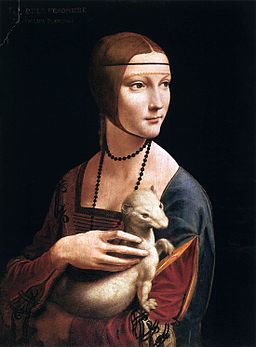The other night Rich and I went to a local screening of Leonardo Live. Have you seen it? It’s the behind- the-scenes-look at opening night of London's National Gallery’s Leonardo da Vinci exhibit, which sold out in London until the day it ended, in the middle of February. Produced by the same company that brings the Metropolitan Opera to millions, this presentation is mesmerizing.
Touted as a once-in-a-century exhibit, museums from Paris to Krakow loaned their works for a show that saw both of da Vinci’s Virgin of the Rocks paintings (in the same room, no less), and more than half of his known completed paintings.
The film starts off slowly, with a wide exterior shot of the National Gallery. People are walking by, seemingly unaware of possibly the greatest exhibit we will ever know taking place in the building beside them.
Then the presenters take us inside through the mazes of rooms, where the cameras spin chaotically giving us erratic glimpses of Leonardo’s portraits and drawings, before the throngs of museum goers are let it.
Critics and glitterati from all forms of art expound on why da Vinci matters. It all takes on a rock-star feel, instead of a medieval one, and I admit, I’m somewhat dubious about the whole thing.
But the moment I catch sight of the painting, Lady with an Ermine, something happens. My heart shifts and I whisper “Oh, My God,” while Rich sighs.
Her skin resembles porcelain and her hand has taken on a life of its own. Those fingers caressing the ermine seem to have blood coursing through them. You can actually see the wrinkles around her knuckles, the ridges on the fingernails. How long did it take da Vinci to get that right? I wonder.
“She’s somebody I could write a song about.” It’s the first line in my husband’s novel, Wrestling Sturbridge, and I feel that way about the Lady.
The presenters talk to musicians, actors and historians, but I keep hoping they come back to The Lady With An Ermine.
Then we meet the Gallery’s restorer, and the woodcutter who created the missing pieces of the gilded frame around the National Gallery's Virgin of the Rocks.
He’s chiseling it all out by hand, tiny flower buds, petal-by-petal, with what looks like a screwdriver. I start to cry. Through this humble-looking woodcutter, I get a sense of just how labor-intensive art is—of what goes into a restoration, of what it takes to display a masterpiece and of the life of the master himself. It seems like an impossible task—the rosettes barely the size of a thumbnail; the painting, more than 6 feet tall. But in the end, we see it surrounding the painting, how they seem as one.
Why did Leonardo da Vinci have so many unfinished works? was the joke of the night. But who could blame him? The far more astounding question for me is, how did he manage to complete so many? Focusing on just one of his finished oil paintings can alter the way you see things.
I agonize over every line in my novels, but a painting the magnitude and genius that was da Vinci took decades. Before there were even painstakingly accurate brush strokes, there was his studious devotion to anatomy, for we’re told Leonardo never considered himself a painter.
“I have been impressed with the urgency of doing,” da Vinci once said. “Knowing is not enough; we must apply. Being willing is not enough; we must do.”
Be more than willing. Go see Leonardo Live.






